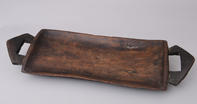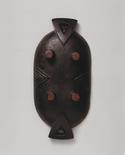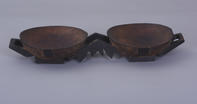Meat platters are still commonly commissioned by rural Zulu-speaking communities for use on important ceremonial occasions such as weddings, celebrations to honour the ancestors and funerals.

Because these platters are used to serve ritually slaughtered meat, they function as invocations of the presence and protection the dead provide to the living. Specialist carvers often sell meat platters at roadside stalls or agricultural markets such as the monthly Mona market near Nongoma in northern KwaZulu-Natal.

The underside of meat platters are almost invariably decorated with intricately carved incised or raised motifs. Although the reason for this practice is not clear, it is probably related to the fact that two platters are commonly used to serve meat, one of which acts as a lid. When not in use, the decorated undersides of these platters are exposed by leaning them against walls or storing them in the thatched rafters of homesteads.

The styles of meat platters vary substantially from one carver to another. Some even point to the influence of decorative traditions associated with the craft teachings of early missionaries and the shapes of non-indigenous ceramic containers. The ongoing importance contemporary traditionalists ascribe to these platters stems from the ritual importance ascribed to cattle.
As Berglund (1976) explains, the cattle of a homestead are not the property of the father of the homestead only, but also of the lineage ancestors: ‘When they (i.e. the ancestors) are complaining of hunger, they are calling for food from their own flock’.

Some carvers take great pride in producing inventive design solutions for meat platters. Several specialise in making platters with two or even three bowls. Complex variations in the treatment of the handles and legs are also quite common.